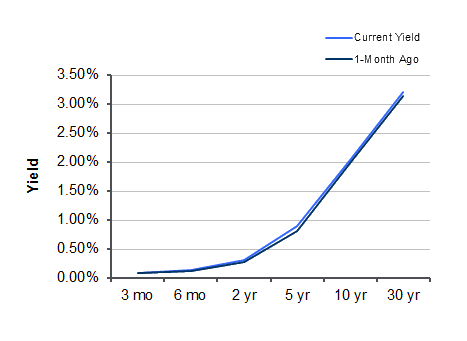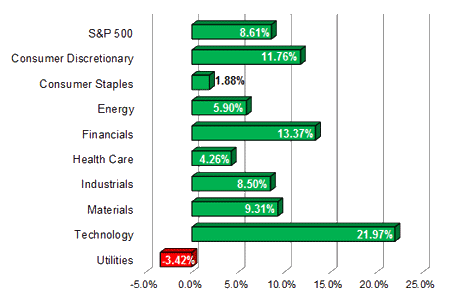
Market Commentary by Scott J. Brown, Ph.D., Chief Economist

Worries about the Greek debt swap agreement weighed against global stock markets earlier in the week, but confidence returned as the Greek deal looked like it would succeed. The February job market figures were strong, a positive for equities and a negative for bonds, but most of that news was already factored in.
Nonfarm payrolls rose by 227,000 in February, while the two previous months were revised a net 61,000 higher (leaving the three-month average at 245,000). The unemployment rate held steady at 8.3%, but that was despite an increase in labor force participation (which rose from 63.7% to 63.9%). The employment-to-population ratio edged up to 58.6%, vs. 58.5% in January and 58.4% in December. It’s likely that the unusually mild winter had a significant impact on payrolls, hours, and labor force participation.
The household survey showed that 178,000 were unable to work during the survey week due to adverse weather – that compares to a 484,000 average over the last five Februarys. Thus, mild weather may have pulled forward seasonal gains that would otherwise have occurred in March or April. In addition, higher gasoline prices could dampen the pace of new hiring over the near term.
Next week, the reports on retail sales and industrial production are expected to reflect a continued economic recovery. The Fed policy meeting is expected to result in no change, despite some talk recently of “sterilized” QE3 (that’s were the Fed would buy long-term assets to push long-term rates lower, and reverse repo short-term securities to leave the size of the balance sheet unchanged).
Indices
| Last | Last Week | YTD return % | |
| DJIA | 12907.94 | 12980.30 | 5.65% |
| NASDAQ | 2970.42 | 2988.97 | 14.02% |
| S&P 500 | 1365.91 | 1374.09 | 8.61% |
| MSCI EAFE | 1548.16 | 1570.58 | 9.60% |
| Russell 2000 | 806.34 | 815.22 | 8.83% |
Consumer Money Rates
| Last | 1-year ago | |
| Prime Rate | 3.25 | 3.25 |
| Fed Funds | 0.13 | 0.16 |
| 30-year mortgage | 3.88 | 4.85 |
Currencies
| Last | 1-year ago | |
| Dollars per British Pound | 1.582 | 1.616 |
| Dollars per Euro | 1.326 | 1.391 |
| Japanese Yen per Dollar | 81.520 | 82.670 |
| Canadian Dollars per Dollar | 0.991 | 0.972 |
| Mexican Peso per Dollar | 12.733 | 12.008 |
Commodities
| Last | 1-year ago | |
| Crude Oil | 106.58 | 105.02 |
| Gold | 1698.03 | 1427.95 |
Bond Rates
| Last | 1-month ago | |
| 2-year treasury | 0.31 | 0.27 |
| 10-year treasury | 2.04 | 1.98 |
| 10-year municipal (TEY) | 3.20 | 2.85 |
Treasury Yield Curve– 3/09/2012
S&P Sector Performance (YTD) – 3/09/2012
| March 13th |
— |
Small Business Optimism (February) Retail Sales (February) FOMC Policy Decision (no press briefing) |
| March 14th |
— |
Import Prices (February) Current Account Deficit (4Q11) |
| March 15th |
— |
Jobless Claims (week ending February 10th) Producer Price Index (February) Empire State Manufacturing Index (March) Philadelphia Fed Index (March) |
| March 16th |
— |
Consumer Price Index (February) Industrial Production (February) Consumer Sentiment (med-March) |
| March 20th |
— |
Building Permits, Housing Starts (February) |
| April 6th |
— |
Good Friday (stock market closed, bonds open half a day) Employment Report (March) |
| April 25th |
— |
FOMC Policy Decision Bernanke Press Briefing |
Important Disclosures
US government bonds and treasury bills are guaranteed by the US government and, if held to maturity, offer a fixed rate of return and guaranteed principal value. US government bonds are issued and guaranteed as to the timely payment of principal and interest by the federal government. Treasury bills are certificates reflecting short-term (less than one year) obligations of the US government.
Commodities trading is generally considered speculative because of the significant potential for investment loss. Markets for commodities are likely to be volatile and there may be sharp price fluctuations even during periods when prices overall are rising. Specific sector investing can be subject to different and greater risks than more diversified investments.
Tax Equiv Muni yields (TEY) assume a 35% tax rate on triple-A rated, tax-exempt insured revenue bonds.
![]() Material prepared by Raymond James for use by its financial advisors.
Material prepared by Raymond James for use by its financial advisors.
The information contained herein has been obtained from sources considered reliable, but we do not guarantee that the foregoing material is accurate or complete. Data source: Bloomberg, as of close of business March 1st, 2012.
©2012 Raymond James Financial Services, Inc. member FINRA / SIPC.




